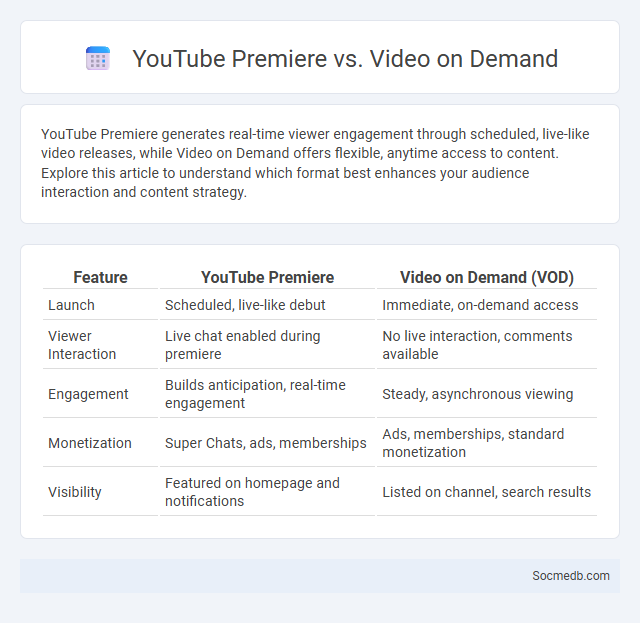
Photo illustration: YouTube Premiere vs Video on Demand
YouTube Premiere generates real-time viewer engagement through scheduled, live-like video releases, while Video on Demand offers flexible, anytime access to content. Explore this article to understand which format best enhances your audience interaction and content strategy.
Table of Comparison
| Feature | YouTube Premiere | Video on Demand (VOD) |
|---|---|---|
| Launch | Scheduled, live-like debut | Immediate, on-demand access |
| Viewer Interaction | Live chat enabled during premiere | No live interaction, comments available |
| Engagement | Builds anticipation, real-time engagement | Steady, asynchronous viewing |
| Monetization | Super Chats, ads, memberships | Ads, memberships, standard monetization |
| Visibility | Featured on homepage and notifications | Listed on channel, search results |
Introduction to Video Release Methods
Video release methods on social media encompass uploading directly to platforms like YouTube, Instagram, and Facebook, optimizing for native playback and algorithm preferences. Leveraging scheduled posts and live streaming enhances audience engagement and reach by targeting peak activity times. Utilizing platform-specific features such as Stories, Reels, and IGTV maximizes visibility and interaction through tailored content formats.
What is YouTube Premiere?
YouTube Premiere is a feature that allows you to schedule and launch new videos as live events, creating a shared viewing experience for your audience. It combines the excitement of a live stream with the permanence of a regular upload, enabling real-time interaction through live chat. Your viewers can watch together, comment, and engage, boosting engagement and anticipation around your content.
Understanding Video on Demand (VOD)
Video on Demand (VOD) transforms how you consume social media content by allowing instant access to videos anytime, enhancing user engagement and personalization. Platforms like YouTube, Netflix, and Hulu leverage VOD technology to offer tailored recommendations based on viewing history, driving higher retention rates. Understanding VOD's impact on social media strategy enables brands to optimize content delivery and maximize audience reach effectively.
What Does Premiere Mean on Streaming Platforms?
Premiere on streaming platforms signifies the scheduled release of new content, allowing viewers to watch simultaneously at a specific time, creating shared experiences and boosting engagement. This feature enhances social media interaction by encouraging live chats, comments, and reactions during the premiere event. Your audience gains excitement and anticipation, increasing visibility and fostering community connection around the content.
Key Features Comparison: YouTube Premiere vs VOD vs Premiere
YouTube Premiere enables creators to schedule and launch new videos with a live chat, enhancing real-time audience interaction compared to standard Video on Demand (VOD) content, which allows users to watch videos anytime without live engagement. Unlike VOD, Premieres create anticipation through a countdown and synchronized playback, fostering community participation at launch time. The key difference lies in interactive features and event-like viewing experiences of Premieres versus the on-demand accessibility and user control inherent in traditional VOD formats.
Audience Engagement Differences
Audience engagement on social media varies significantly across platforms, with visual-centric sites like Instagram and TikTok driving higher interaction rates through compelling imagery and short videos. Twitter excels in real-time conversations and trending topics, fostering dynamic engagement via retweets, replies, and hashtag use. Facebook's diverse user base supports deeper community connections and longer-form content, resulting in varied engagement types such as comments, shares, and group interactions.
Monetization Opportunities
Social media platforms offer diverse monetization opportunities including sponsored content, affiliate marketing, and direct product sales, enabling creators and businesses to generate significant revenue. Leveraging advanced targeting algorithms, you can reach your ideal audience efficiently, maximizing engagement and conversion rates. Utilizing tools like branded partnerships and in-app shopping features further enhances your potential for consistent income streams on platforms such as Instagram, TikTok, and YouTube.
Use Cases for Each Release Method
Social media platforms offer diverse release methods tailored to specific marketing goals: scheduled posts enable precise timing to engage audiences during peak activity hours, while live streaming facilitates real-time interaction and immediate feedback, boosting user engagement. Story features provide ephemeral content for time-sensitive promotions, creating urgency and increasing viewer retention. Your choice of release method should align with content type and target audience behavior to maximize visibility and conversion rates.
Pros and Cons Breakdown
Social media enhances connectivity by enabling real-time communication and expanding network opportunities for individuals and businesses. It offers powerful marketing tools and access to diverse information, fostering community engagement and brand growth. However, social media poses risks such as privacy breaches, misinformation spread, and potential negative impacts on mental health due to excessive use or cyberbullying.
Choosing the Right Release Strategy
Selecting the right social media release strategy is crucial for maximizing your content's reach and engagement. Tailor your approach by analyzing platform-specific user behaviors, optimal posting times, and content formats that resonate with your target audience. Ensuring alignment between your messaging and audience preferences increases visibility and drives higher interaction rates, making your campaigns more effective.
 socmedb.com
socmedb.com